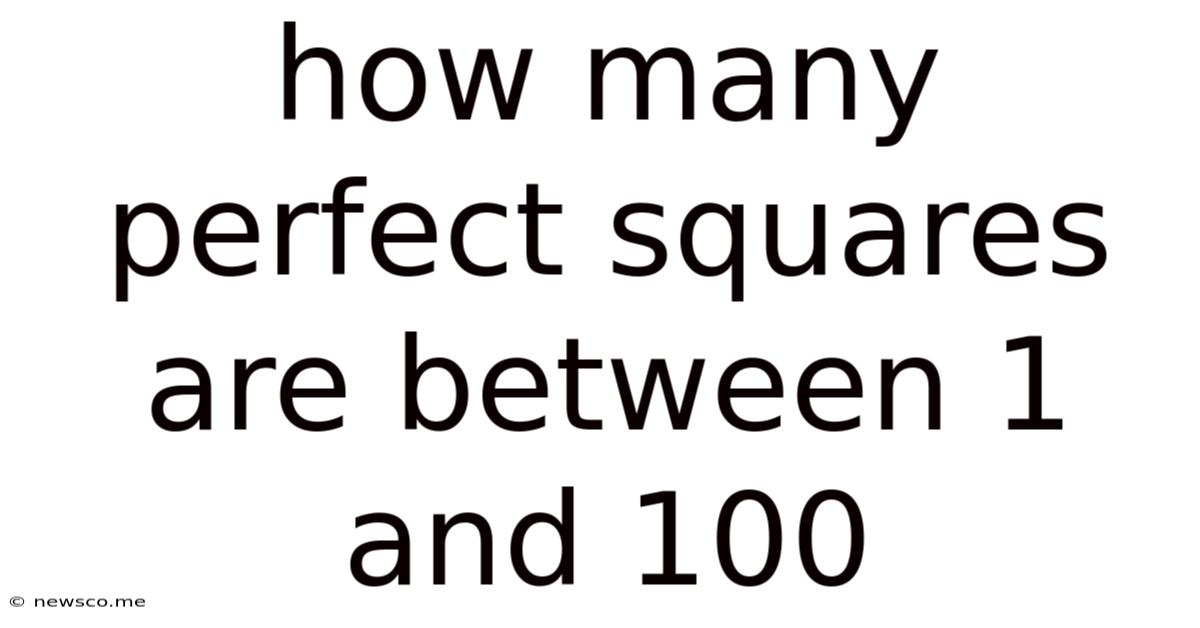How Many Perfect Squares Are Between 1 And 100
News Co
May 07, 2025 · 4 min read

Table of Contents
How Many Perfect Squares Are Between 1 and 100? A Deep Dive into Number Theory
Finding the number of perfect squares between 1 and 100 might seem like a simple task, a quick mental calculation for many. But this seemingly straightforward question opens a door to a fascinating exploration of number theory, perfect squares, and the elegance of mathematical patterns. This article delves deep into this seemingly simple problem, exploring the underlying concepts and extending the investigation to broader mathematical landscapes.
Understanding Perfect Squares
Before we embark on counting, let's solidify our understanding of what constitutes a perfect square. A perfect square, in mathematical terms, is a number that can be obtained by squaring an integer. In simpler words, it's the result of multiplying an integer by itself. For instance:
- 1 (1 x 1)
- 4 (2 x 2)
- 9 (3 x 3)
- 16 (4 x 4)
- and so on...
These numbers are characterized by their unique property of having an integer square root. This property forms the cornerstone of our investigation into the number of perfect squares between 1 and 100.
The Direct Approach: Counting the Squares
The most straightforward method to solve our problem is to simply list all the perfect squares between 1 and 100 and count them. Let's do just that:
- 1² = 1
- 2² = 4
- 3² = 9
- 4² = 16
- 5² = 25
- 6² = 36
- 7² = 49
- 8² = 64
- 9² = 81
- 10² = 100
By carefully examining this list, we can see that there are ten perfect squares between 1 and 100 (inclusive).
A More Mathematical Approach: Using Inequalities
Instead of manual counting, we can leverage mathematical inequalities to arrive at the same answer more efficiently. We know that we are looking for integers 'n' such that:
1 ≤ n² ≤ 100
To solve this inequality, we can take the square root of all parts of the inequality:
√1 ≤ √n² ≤ √100
This simplifies to:
1 ≤ n ≤ 10
This inequality tells us that 'n' can be any integer from 1 to 10, inclusive. Therefore, there are 10 perfect squares between 1 and 100. This method provides a more elegant and generalizable solution than simple counting.
Extending the Concept: Perfect Squares Between Any Two Numbers
The method using inequalities is particularly powerful because it can be easily adapted to find the number of perfect squares between any two given numbers, say 'a' and 'b'. The approach would be:
√a ≤ n ≤ √b
Where 'n' is an integer. The number of perfect squares would then be determined by the difference between the integer parts of √b and √a, plus one (to include both endpoints if they are perfect squares).
For example, let's find the number of perfect squares between 25 and 225:
√25 ≤ n ≤ √225
5 ≤ n ≤ 15
The integers satisfying this inequality are 5, 6, 7, 8, 9, 10, 11, 12, 13, 14, and 15. This gives us a total of 11 perfect squares.
The Significance of Perfect Squares in Mathematics
Perfect squares are far more than just simple mathematical objects; they play a crucial role in various areas of mathematics and its applications:
1. Geometry: Area Calculations
In geometry, perfect squares represent the areas of squares with integer side lengths. This fundamental connection is essential for understanding area calculations and geometric problem-solving.
2. Number Theory: Diophantine Equations
Perfect squares are integral to many number theory problems, especially Diophantine equations—equations where only integer solutions are sought. Many famous problems, such as Fermat's Last Theorem, involve perfect squares and their properties.
3. Algebra: Quadratic Equations
Perfect squares are fundamentally linked to quadratic equations. Completing the square, a crucial technique for solving quadratic equations, relies heavily on the properties of perfect squares.
4. Computer Science: Computational Complexity
The concept of perfect squares is relevant in computer science, particularly in algorithm analysis and computational complexity. The efficiency of certain algorithms is often analyzed in terms of square root operations or comparisons with perfect squares.
Exploring Beyond the Basics: Further Investigations
Having established a firm grasp on finding the number of perfect squares within a given range, we can explore more complex related problems:
-
Perfect Squares with Specific Properties: We could investigate perfect squares that are also divisible by a certain number, or perfect squares that end in a specific digit.
-
Perfect Squares and Prime Numbers: The interplay between perfect squares and prime numbers is a rich area of study in number theory. We could explore the distribution of primes related to perfect squares.
-
Higher Powers: Extending the concept to cubes (n³), fourth powers (n⁴), and other higher powers opens up a new dimension of mathematical exploration.
Conclusion: From Simple Counting to Deep Mathematical Insight
What began as a seemingly simple question—how many perfect squares are between 1 and 100—has led us on a journey through the fascinating world of number theory. We've learned several methods for solving this problem, from direct counting to the more elegant approach of using inequalities. This journey has highlighted the importance of perfect squares in various mathematical fields and hinted at the wealth of unexplored mathematical territory surrounding them. The seemingly simple can often unlock profound mathematical beauty and understanding. Keep exploring, keep questioning, and keep discovering the hidden elegance within numbers.
Latest Posts
Related Post
Thank you for visiting our website which covers about How Many Perfect Squares Are Between 1 And 100 . We hope the information provided has been useful to you. Feel free to contact us if you have any questions or need further assistance. See you next time and don't miss to bookmark.